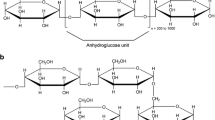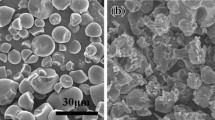Abstract
Carbohydrate polymers are promising materials for an eco-friendly future due to their biodegradability and abundance in nature. However, due to their molecular characteristics and hydrophilicity, are often complicated to be investigated via spectroscopic methods. Thermoplastic starch plasticized by glycerol was prepared through melt processing conditions using twin screw extruder. Here we show how the presence of water molecules affects the dielectric response and charge transport dynamics over broad frequency (10−1 to 107 Hz) and temperature (− 140 to 150 oC) ranges. Overall, 7 dielectric processes were observed and differentiation between electronic and ionic conductivities was achieved. Two segmental relaxation processes were observed for each sample, ascribed to the starch-rich and glycerol-rich phases. Although the timescales of the two segmental relaxations were found different, both arise from the same temperature, giving thus an alternative explanation on what is reported in the literature. The origin of the σ-relaxation was attributed to hydrogen ions and was found to be proportional to the ionic conductivity according to the Barton, Nakajima and Namikawa relation. The presence of water molecules was found to enhance the ionic conductivity, indicating that water contributes charge carriers when compared to the dried sample.
Graphical Abstract






Similar content being viewed by others
References
Newell P (2019) Trasformismo or transformation? The global political economy of energy transitions. Rev Int Polit Econ 26:25–48. https://doi.org/10.1080/09692290.2018.1511448
Krauss LM (2021) Physics of climate change. Apollo, New York
Chung Y-L, Ansari S, Estevez L et al (2010) Preparation and properties of biodegradable starch–clay nanocomposites. Carbohydr Polym 79:391–396. https://doi.org/10.1016/j.carbpol.2009.08.021
Karger-Kocsis J, Kmetty Á, Lendvai L et al (2014) Water-assisted production of thermoplastic nanocomposites: a review. Materials 8:72–95. https://doi.org/10.3390/ma8010072
Kyrikou I, Briassoulis D (2007) Biodegradation of agricultural plastic films: a critical review. J Polym Environ 15:125–150. https://doi.org/10.1007/s10924-007-0053-8
Nocita D, Forte G, Drakopoulos SX et al (2017) Processing and characterization of bio-polyester reactive blends: from thermoplastic blends to cross-linked networks. Polymer 132:252–263. https://doi.org/10.1016/j.polymer.2017.10.069
Visco A, Nocita D, Giamporcaro A et al (2017) Effect of Ethyl Ester L-Lysine triisocyanate addition to produce reactive PLA/PCL bio-polyester blends for biomedical applications. J Mech Behav Biomed Mater 68:308–317. https://doi.org/10.1016/j.jmbbm.2017.02.018
Loukelis K, Papadogianni D, Chatzinikolaidou M (2022) Kappa-carrageenan/chitosan/gelatin scaffolds enriched with potassium chloride for bone tissue engineering. Int J Biol Macromol 209:1720–1730. https://doi.org/10.1016/j.ijbiomac.2022.04.129
Loukelis K, Helal ZA, Mikos AG, Chatzinikolaidou M (2023) Nanocomposite bioprinting for tissue Engineering Applications. Gels 9:103. https://doi.org/10.3390/gels9020103
Strachota B, Strachota A, Šlouf M et al (2019) Monolithic intercalated PNIPAm/starch hydrogels with very fast and extensive one-way volume and swelling responses to temperature and pH: prospective actuators and drug release systems. Soft Matter 15:752–769. https://doi.org/10.1039/C8SM02153H
Peidayesh H, Mosnáčková K, Špitalský Z et al (2021) Thermoplastic starch–based composite reinforced by conductive filler networks: physical properties and electrical conductivity changes during cyclic deformation. Polymers 13:3819. https://doi.org/10.3390/polym13213819
Sun T, Zhu C, Xu J (2018) Multiple stimuli-responsive selenium-functionalized biodegradable starch-based hydrogels. Soft Matter 14:921–926. https://doi.org/10.1039/C7SM02137B
Cyras VP, Manfredi LB, Ton-That M-T, Vázquez A (2008) Physical and mechanical properties of thermoplastic starch/montmorillonite nanocomposite films. Carbohydr Polym 73:55–63. https://doi.org/10.1016/j.carbpol.2007.11.014
Soykeabkaew N, Thanomsilp C, Suwantong O (2015) A review: starch-based composite foams. Compos Part A: Appl Sci Manuf 78:246–263. https://doi.org/10.1016/j.compositesa.2015.08.014
Shi R, Liu Q, Ding T et al (2007) Ageing of soft thermoplastic starch with high glycerol content. J Appl Polym Sci 103:574–586. https://doi.org/10.1002/app.25193
Lendvai L, Karger-Kocsis J, Kmetty Á, Drakopoulos SX (2016) Production and characterization of microfibrillated cellulose-reinforced thermoplastic starch composites. J Appl Polym Sci 133:42397. https://doi.org/10.1002/app.42397
Lendvai L, Sajó I, Karger-Kocsis J (2019) Effect of Storage Time on the structure and Mechanical Properties of Starch/Bentonite Nanocomposites. Starch - Stärke 71:1800123. https://doi.org/10.1002/star.201800123
Baran A, Fričová O, Vrábel P et al (2022) Effects of urea and glycerol mixture on morphology and molecular mobility in thermoplastic starch/montmorillonite-type nanofiller composites studied using XRD and NMR. J Polym Res 29:257. https://doi.org/10.1007/s10965-022-03110-6
Peidayesh H, Heydari A, Mosnáčková K, Chodák I (2021) In situ dual crosslinking strategy to improve the physico-chemical properties of thermoplastic starch. Carbohydr Polym 269:118250. https://doi.org/10.1016/j.carbpol.2021.118250
Singh T, Gangil B, Patnaik A et al (2019) Agriculture waste reinforced corn starch-based biocomposites: effect of rice husk/walnut shell on physicomechanical, biodegradable and thermal properties. Mater Res Express 6:045702. https://doi.org/10.1088/2053-1591/aafe45
Müller P, Kapin É, Fekete E (2014) Effects of preparation methods on the structure and mechanical properties of wet conditioned starch/montmorillonite nanocomposite films. Carbohydr Polym 113:569–576. https://doi.org/10.1016/j.carbpol.2014.07.054
van Soest JJG, Vliegenthart JFG (1997) Crystallinity in starch plastics: consequences for material properties. Trends Biotechnol 15:208–213. https://doi.org/10.1016/S0167-7799(97)01021-4
Avérous L (2004) Biodegradable multiphase systems based on plasticized starch: a review. J Macromol Sci Part C: Polym Rev 44:231–274. https://doi.org/10.1081/MC-200029326
Majdzadeh-Ardakani K, Navarchian AH, Sadeghi F (2010) Optimization of mechanical properties of thermoplastic starch/clay nanocomposites. Carbohydr Polym 79:547–554. https://doi.org/10.1016/j.carbpol.2009.09.001
Xie F, Pollet E, Halley PJ, Avérous L (2013) Starch-based nano-biocomposites. Prog Polym Sci 38:1590–1628. https://doi.org/10.1016/j.progpolymsci.2013.05.002
Lendvai L, Apostolov A, Karger-Kocsis J (2017) Characterization of layered silicate-reinforced blends of thermoplastic starch (TPS) and poly(butylene adipate-co-terephthalate). Carbohydr Polym 173:566–572. https://doi.org/10.1016/j.carbpol.2017.05.100
Halley PJ, Dorgan JR (2011) Next-generation biopolymers: advanced functionality and improved sustainability. MRS Bull 36:687–691. https://doi.org/10.1557/mrs.2011.180
Yalpani M (1988) Polysaccharides: syntheses, modifications, and structure/property relations. Elsevier, Amsterdam
Einfeldt J, Meißner D, Kwasniewski A (2001) Polymerdynamics of cellulose and other polysaccharides in solid state-secondary dielectric relaxation processes. Prog Polym Sci 26:1419–1472. https://doi.org/10.1016/S0079-6700(01)00020-X
Kremer F, Schönhals A (2003) Broadband dielectric spectroscopy. Springer, Berlin
Psarras GC (2010) Conductivity and dielectric characterization of polymer nanocomposites. In: Tjong SC, Mai YW (eds) Physical properties and applications of polymer nanocomposites. Elsevier, Amsterdam, pp 31–69
Psarras GC (2018) Fundamentals of dielectric theories. In: Dang ZM (ed) Dielectric polymer materials for high-density energy storage. Elsevier, Amsterdam, pp 11–57
Klonos PA, Terzopoulou Z, Zamboulis A et al (2022) Direct and indirect effects on molecular mobility in renewable polylactide–poly(propylene adipate) block copolymers as studied via dielectric spectroscopy and calorimetry. Soft Matter 18:3725–3737. https://doi.org/10.1039/D2SM00261B
Šmídová N, Peidayesh H, Baran A et al (2023) Influence of air humidity level on the structure and mechanical properties of thermoplastic starch-montmorillonite nanocomposite during storage. Materials 16:900. https://doi.org/10.3390/ma16030900
Tsangaris GM, Psarras GC, Kouloumbi N (1998) Electric modulus and interfacial polarization in composite polymeric systems. J Mater Sci 33:2027–2037. https://doi.org/10.1023/A:1004398514901
Gerhardt R (1994) Impedance and dielectric spectroscopy revisited: distinguishing localized relaxation from long-range conductivity. J Phys Chem Solids 55:1491–1506. https://doi.org/10.1016/0022-3697(94)90575-4
Drakopoulos SX, Karger-Kocsis J, Kmetty Á et al (2017) Thermoplastic starch modified with microfibrillated cellulose and natural rubber latex: a broadband dielectric spectroscopy study. Carbohydr Polym 157:711–718. https://doi.org/10.1016/j.carbpol.2016.10.036
Anglès MN, Dufresne A (2000) Plasticized Starch/Tunicin whiskers nanocomposites. 1. Struct Anal Macromol 33:8344–8353. https://doi.org/10.1021/ma0008701
Drakopoulos SX, Karger-Kocsis J, Psarras GC (2020) The effect of micro‐fibrillated cellulose upon the dielectric relaxations and DC conductivity in thermoplastic starch bio‐composites. J Appl Polym Sci 137:49573. https://doi.org/10.1002/app.49573
Havriliak S, Negami S (1967) A complex plane representation of dielectric and mechanical relaxation processes in some polymers. Polymer 8:161–210. https://doi.org/10.1016/0032-3861(67)90021-3
Drakopoulos SX, Patsidis AC, Psarras GC (2022) Epoxy-based/BaTiO3 nanodielectrics: relaxation dynamics, charge transport and energy storage. Mater Res Bull 145:111537. https://doi.org/10.1016/j.materresbull.2021.111537
Johari GP, Goldstein M (1971) Viscous liquids and the glass transition. III. Secondary relaxations in aliphatic alcohols and other nonrigid molecules. J Chem Phys 55:4245–4252. https://doi.org/10.1063/1.1676742
Schröter K, Donth E (2000) Viscosity and shear response at the dynamic glass transition of glycerol. J Chem Phys 113:9101–9108. https://doi.org/10.1063/1.1319616
Drakopoulos SX, Karger-Kocsis J, Psarras GC (2019) In situ thermodielectric analysis of the gelatinization mechanism of raw maize starch: an experimental and theoretical approach. J Polym Environ 27:333–342. https://doi.org/10.1007/s10924-018-1348-7
Mascia L, Kouparitsas Y, Nocita D, Bao X (2020) Antiplasticization of polymer materials: structural aspects and effects on mechanical and diffusion-controlled properties. Polymers 12:769. https://doi.org/10.3390/polym12040769
Forssell PM, Mikkilä JM, Moates GK, Parker R (1997) Phase and glass transition behaviour of concentrated barley starch-glycerol-water mixtures, a model for thermoplastic starch. Carbohydr Polym 34:275–282. https://doi.org/10.1016/S0144-8617(97)00133-1
Schmitt H, Guidez A, Prashantha K et al (2015) Studies on the effect of storage time and plasticizers on the structural variations in thermoplastic starch. Carbohydr Polym 115:364–372. https://doi.org/10.1016/j.carbpol.2014.09.004
Adam G, Gibbs JH (1965) On the temperature dependence of cooperative relaxation properties in glass-forming liquids. J Chem Phys 43:139–146. https://doi.org/10.1063/1.1696442
Berthier L, Biroli G, Bouchaud J-P et al (2005) Direct experimental evidence of a growing length scale accompanying the Glass Transition. Science 310:1797–1800. https://doi.org/10.1126/science.1120714
Bauer Th, Lunkenheimer P, Loidl A (2013) Cooperativity and the freezing of molecular motion at the glass transition. Phys Rev Lett 111:225702. https://doi.org/10.1103/PhysRevLett.111.225702
Einfeldt J, Meißner D, Kwasniewski A (2003) Contributions to the molecular origin of the dielectric relaxation processes in polysaccharides – the high temperature range. J Non-cryst Solids 320:40–55. https://doi.org/10.1016/S0022-3093(03)00086-3
Karan N, Pradhan D, Thomas R et al (2008) Solid polymer electrolytes based on polyethylene oxide and lithium trifluoro- methane sulfonate (PEO–LiCF3SO3): ionic conductivity and dielectric relaxation. Solid State Ionics 179:689–696. https://doi.org/10.1016/j.ssi.2008.04.034
Fragiadakis D, Dou S, Colby RH, Runt J (2008) Molecular mobility, Ion mobility, and mobile ion concentration in poly(ethylene oxide)-based polyurethane ionomers. Macromolecules 41:5723–5728. https://doi.org/10.1021/ma800263b
Serghei A, Tress M, Sangoro JR, Kremer F (2009) Electrode polarization and charge transport at solid interfaces. Phys Rev B 80:184301. https://doi.org/10.1103/PhysRevB.80.184301
Yang H, Glynos E, Huang B, Green PF (2013) Out-of-plane Carrier Transport in Conjugated Polymer Thin Films: role of morphology. J Phys Chem C 117:9590–9597. https://doi.org/10.1021/jp402254r
Angell CA (1997) Why C1 = 16–17 in the WLF equation is physical—and the fragility of polymers. Polymer 38:6261–6266
Wang Y, Fan F, Agapov AL et al (2014) Examination of the fundamental relation between ionic transport and segmental relaxation in polymer electrolytes. Polymer 55:4067–4076. https://doi.org/10.1016/j.polymer.2014.06.085
Puzenko A, Hayashi Y, Ryabov YE et al (2005) Relaxation dynamics in glycerol – water mixtures: I. glycerol-rich mixtures. J Phys Chem B 109:6031–6035. https://doi.org/10.1021/jp0445122
Capponi S, Napolitano S, Behrnd NR et al (2010) Structural relaxation in nanometer thin layers of glycerol. J Phys Chem C 114:16696–16699. https://doi.org/10.1021/jp108151p
Pipertzis A, Papamokos G, Mühlinghaus M et al (2020) What determines the glass temperature and dc-conductivity in imidazolium-polymerized ionic liquids with a polythiophene backbone? Macromolecules 53:3535–3550. https://doi.org/10.1021/acs.macromol.0c00226
Namikawa H (1975) Characterization of the diffusion process in oxide glasses based on the correlation between electric conduction and dielectric relaxation. J Non-cryst Solids 18:173–195. https://doi.org/10.1016/0022-3093(75)90019-8
Dyre JC (1988) The random free-energy barrier model for ac conduction in disordered solids. J Appl Phys 64:2456–2468. https://doi.org/10.1063/1.341681
Dyre JC, Schrøder TB (2000) Universality of ac conduction in disordered solids. Rev Mod Phys 72:873–892. https://doi.org/10.1103/RevModPhys.72.873
Zardalidis G, Ioannou E, Pispas S, Floudas G (2013) Relating structure, viscoelasticity, and local mobility to Conductivity in PEO/LiTf electrolytes. Macromolecules 46:2705–2714. https://doi.org/10.1021/ma400266w
Acknowledgements
The authors would like to thank professor Dr. Ivan Chodák (Slovak Academy of Sciences, Slovakia) for valuable discussions over TPS-based materials and for reading and providing with constructive comments about the manuscript prior to submission.
Funding
H.P. would like to acknowledge financial help from The Slovak Grant Agency under the project number VEGA 2/0109/23.
Author information
Authors and Affiliations
Contributions
SXD: Conceptualization, Methodology, Formal analysis, Data curation, Writing—original draft, Writing—review & editing, Visualization, Supervision. ZŠ: Methodology, Validation, Investigation, Resources, Writing—review & editing. HP: Methodology, Validation, Investigation, Writing—review & editing. LL: Conceptualization, Methodology, Investigation, Writing—review & editing, Supervision, Project administration, Funding acquisition.
Corresponding authors
Ethics declarations
Conflict of interest
There are no conflicts of interest to declare.
Additional information
Publisher’s Note
Springer Nature remains neutral with regard to jurisdictional claims in published maps and institutional affiliations.
Rights and permissions
Springer Nature or its licensor (e.g. a society or other partner) holds exclusive rights to this article under a publishing agreement with the author(s) or other rightsholder(s); author self-archiving of the accepted manuscript version of this article is solely governed by the terms of such publishing agreement and applicable law.
About this article
Cite this article
Drakopoulos, S.X., Špitalský, Z., Peidayesh, H. et al. The Effect of Drying of Glycerol-Plasticized Starch upon Its Dielectric Relaxation Dynamics and Charge Transport. J Polym Environ 31, 5389–5400 (2023). https://doi.org/10.1007/s10924-023-02962-3
Accepted:
Published:
Issue Date:
DOI: https://doi.org/10.1007/s10924-023-02962-3




